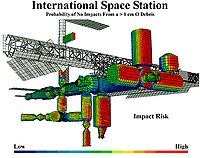
Photo from wikipedia
We consider a scenario where a team of robots with heterogeneous sensors must track a set of targets or hazards which may induce sensory failures on the robots. In particular,… Click to show full abstract
We consider a scenario where a team of robots with heterogeneous sensors must track a set of targets or hazards which may induce sensory failures on the robots. In particular, the likelihood of failures depends on the proximity between the targets and the robots. We propose a control framework that explicitly addresses the competing objectives of tracking quality maximization and sensor preservation (which impacts the future quality of the generated target estimates). Our framework consists of a risk-aware component—which accounts for the risk of suffering sensor failures, and an adaptive component—which balances the aforementioned competing objectives while accounting for failures that have already occurred. Based on a measure of the observability of the tracking process, our framework can generate aggressive as well as safer robot configurations to track the targets. Crucially, the heterogeneous sensing capabilities of the robots are explicitly considered at each step, allowing for a more expressive risk vs. tracking quality trade-off. Real robot experiments with induced sensor failures demonstrate the efficacy of the proposed approach.
Journal Title: IEEE Robotics and Automation Letters
Year Published: 2022
Link to full text (if available)
Share on Social Media: Sign Up to like & get
recommendations!